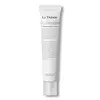What's inside
What's inside
 Key Ingredients
Key Ingredients

 Benefits
Benefits

 Concerns
Concerns

No concerns
 Ingredients Side-by-side
Ingredients Side-by-side

Water
Skin ConditioningGlycerin
HumectantPetrolatum
EmollientPanthenol
Skin ConditioningPentylene Glycol
Skin ConditioningBehenyl Alcohol
EmollientButylene Glycol
HumectantDimethicone
EmollientDecyl Glucoside
CleansingPolysilicone-11
Isosorbide Dicaprylate
Skin ConditioningArachidyl Alcohol
EmollientArachidyl Glucoside
EmulsifyingCetearyl Alcohol
EmollientCetearyl Glucoside
EmulsifyingBisabolol
MaskingCeramide EOP
Skin ConditioningCeramide NP
Skin Conditioning4-T-Butylcyclohexanol
MaskingAvena Sativa Kernel Flour
AbrasiveGlycyrrhetinic Acid
Skin ConditioningAllantoin
Skin ConditioningLinoleic Acid
CleansingLinolenic Acid
CleansingPalmitamide Mea
Cholesterol
EmollientMyristic Acid
CleansingHydroxystearic Acid
CleansingZingiber Officinale Root Extract
MaskingAvena Sativa Kernel Extract
AbrasiveAvenanthramides
AntioxidantHydroxymethoxyphenyl Decanone
Skin ConditioningTocopherol
AntioxidantLactic Acid
BufferingPolyacrylamide
C13-14 Isoparaffin
EmollientTetrasodium Glutamate Diacetate
Laureth-7
EmulsifyingPotassium Sorbate
PreservativeWater, Glycerin, Petrolatum, Panthenol, Pentylene Glycol, Behenyl Alcohol, Butylene Glycol, Dimethicone, Decyl Glucoside, Polysilicone-11, Isosorbide Dicaprylate, Arachidyl Alcohol, Arachidyl Glucoside, Cetearyl Alcohol, Cetearyl Glucoside, Bisabolol, Ceramide EOP, Ceramide NP, 4-T-Butylcyclohexanol, Avena Sativa Kernel Flour, Glycyrrhetinic Acid, Allantoin, Linoleic Acid, Linolenic Acid, Palmitamide Mea, Cholesterol, Myristic Acid, Hydroxystearic Acid, Zingiber Officinale Root Extract, Avena Sativa Kernel Extract, Avenanthramides, Hydroxymethoxyphenyl Decanone, Tocopherol, Lactic Acid, Polyacrylamide, C13-14 Isoparaffin, Tetrasodium Glutamate Diacetate, Laureth-7, Potassium Sorbate
Water
Skin ConditioningGlycerin
HumectantSqualane
EmollientPetrolatum
EmollientCeramide AP
Skin Conditioning1,2-Hexanediol
Skin ConditioningCentella Asiatica Extract
CleansingButylene Glycol
HumectantAcrylates/C10-30 Alkyl Acrylate Crosspolymer
Emulsion StabilisingArginine
MaskingAmmonium Acryloyldimethyltaurate/Vp Copolymer
Caprylyl Glycol
EmollientMadecassoside
AntioxidantAsiaticoside
AntioxidantAsiatic Acid
Skin Conditioning
 Reviews
Reviews

Ingredients Explained
These ingredients are found in both products.
Ingredients higher up in an ingredient list are typically present in a larger amount.
Butylene Glycol (or BG) is used within cosmetic products for a few different reasons:
Overall, Butylene Glycol is a safe and well-rounded ingredient that works well with other ingredients.
Though this ingredient works well with most skin types, some people with sensitive skin may experience a reaction such as allergic rashes, closed comedones, or itchiness.
Learn more about Butylene GlycolGlycerin is already naturally found in your skin. It helps moisturize and protect your skin.
A study from 2016 found glycerin to be more effective as a humectant than AHAs and hyaluronic acid.
As a humectant, it helps the skin stay hydrated by pulling moisture to your skin. The low molecular weight of glycerin allows it to pull moisture into the deeper layers of your skin.
Hydrated skin improves your skin barrier; Your skin barrier helps protect against irritants and bacteria.
Glycerin has also been found to have antimicrobial and antiviral properties. Due to these properties, glycerin is often used in wound and burn treatments.
In cosmetics, glycerin is usually derived from plants such as soybean or palm. However, it can also be sourced from animals, such as tallow or animal fat.
This ingredient is organic, colorless, odorless, and non-toxic.
Glycerin is the name for this ingredient in American English. British English uses Glycerol/Glycerine.
Learn more about GlycerinPetrolatum is more commonly known as petroleum jelly. It is created by mixing waxes and mineral oils.
This ingredient is effective at reducing water loss by 99%. This is because it is an occlusive. Occlusives create a hydrophobic barrier on the skin to prevent evaporation. This property makes it great for hydrating dry skin.
Pro tip: Use occlusives, such as this ingredient, on damp skin for the best results.
The quality or origin of petrolatum is only known when disclosed by the brand. Most cosmetic petrolatum has gone through several purification stages.
Another benefit of occlusives is it protects your skin against infection or allergies.
Petrolatum may not be safe for fungal-acne. Studies show mineral oil / petroleum leads to the growth of M. Furfur, a type of yeast.
Learn more about PetrolatumWater. It's the most common cosmetic ingredient of all. You'll usually see it at the top of ingredient lists, meaning that it makes up the largest part of the product.
So why is it so popular? Water most often acts as a solvent - this means that it helps dissolve other ingredients into the formulation.
You'll also recognize water as that liquid we all need to stay alive. If you see this, drink a glass of water. Stay hydrated!
Learn more about Water